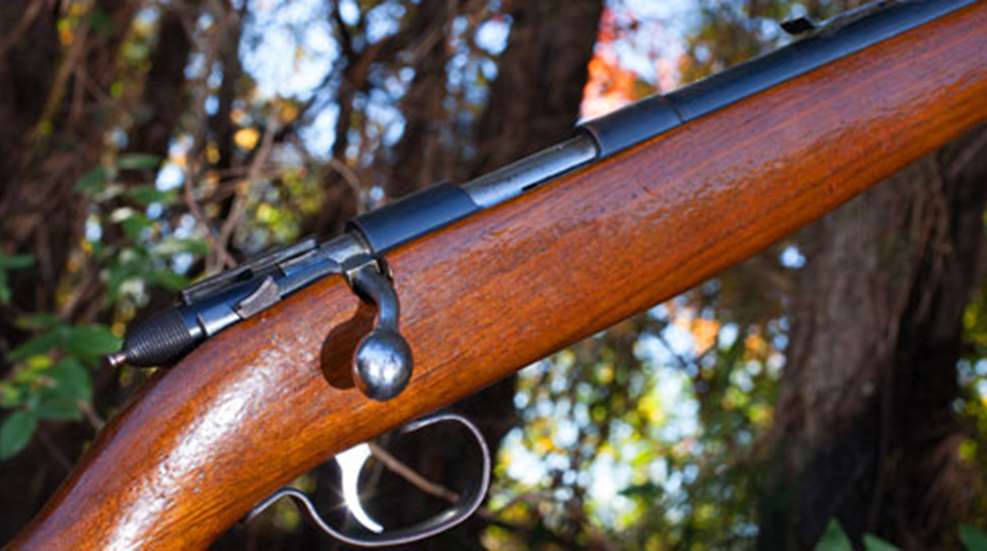
More than a half million TargetMasters were produced by Remington between 1939 and 1962. One of them hangs on my wall as a family heirloom with scars from decades of hunting and two generations of the family-soon to be three-learning the finer points of marksmanship behind its trigger. Odds are pretty good you, or a shooting friend, own at least one TargetMaster 510 variation.
If not, they’re usually a pretty good deal at only about $129, depending on condition. It won’t come with your family history attached, but if you enjoy accurate rimfires it’ll soon earn one.
There are some devoted fans of the TargetMaster 510 posting on the Internet, but finding confirmable details is like trying to find Bigfoot. One of the best sources I found is the “The History of Remington Firearms,” by Roy Marcot.
According to Marcot, Remington’s entire 500 series of rifles shared a cost-saving receiver, “…made from seamless drawn steel tubing, not more expensive forged steel.” The lineup included the 510, 511 (basically a 510 with a magazine), 512, 513 and semi-automatic 550.
The 510A first reached shooters in March, 1939. An improved version was also available with “…a chrome-plated bolt, bolt handle and trigger,” according to Marcot. It looks like my father actually splurged for the extra touch, a rarity in our family.
My 510A’s chrome finish shows years of use and abuse. My father used it regularly for squirrels and rabbits-it was, after all, a working gun. The trigger has vertical serrations on its face to enhance purchase with gloves or inclement weather. Its let-off weight is 3.5 pounds, but bear in mind I’ve been soaking, cleaning and polishing this thing for the past seven months (and as the photo indicates, it still doesn’t look pristine).
Marcot said 501As weigh 4 pounds, 12 ounces, but my rifle is slightly lighter because it is missing the buttplate, although I remedied the problem by ordering one from Numrich.
There is no serial number on this 510A. The Gun Control Act of 1968 requires serial numbers on firearms made after its enactment, but the 510A lineup was discontinued in December, 1962, long before it was mandatory. You can determine a 510’s year of manufacture, however, by checking the letters on the left side of the receiver. The Remington Society has a convenient cross-reference page. Mine was made in June of 1949.
The single-shot 510A is versatile enough to digest .22 Short, .22 Long and .22 Long Rifle. The bolt cocks on opening, whereupon a small red indicator (mine used to be red) protrudes at the back to indicate its status. It has double locking lugs, dual extractors and in all the times afield with my father, it never suffered a stoppage of any sort. A manual safety at the right rear of the receiver has horizontal serrations for added grip-forward to fire, exposing a small red dot, back to engage the safety.
Those accustomed to modern bolt-action rifles will probably find the 510A a little less than hand-filling. It’s thin. The stock is less than 1.5 inches at its widest at the butt, and the front of the fore-end measures slightly more than an inch. It’s sounds spindly, but it’s awesome for a .22, and even better when you’re putting it in the hands of a novice for the first time. My father called it nimble. Whether you like the dimensions or not, the good old American walnut has stood up to 64 years of beating. There is no checkering. Overall length (sans buttplate) is 42 3/4 inches.
A very small crown protects the 25-inch barrel’s rifling. Barrel diameter at the muzzle is .6 of an inch. Stock sights are fixed up front, and windage and elevation adjustable at the rear, according to Marcot. My version has a dovetailed front sight, perhaps yet another artifact from Uncle Johnny, the family’s precision machinist (although the setup is identical to the ScoreMaster also hanging on my wall).
My father’s condition for the last 10 years of his life relegated the rifle to the safe. The barrel didn’t get much maintenance during that period, so it needs more cleaning/conditioning before it undergoes a real accuracy test. In the meantime, I’ll add to the Sasquatch/TargetMaster folklore by the unsubstantiated claim that my father never missed with this rifle. He probably did and I just wasn’t there to witness it, but either way, I can’t wait to put this refurbished TargetMaster in the hands of my youngest grandson. Then I’ll get to work on the other Remington.





































